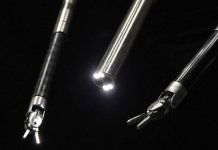
Imagine robots that can feel the world around them like we do, or prosthetic limbs that can sense touch and shape just like our natural limbs.
It sounds like science fiction, right?
But it’s becoming more real, thanks to a team of researchers from the Munich Institute of Robotics and Machine Intelligence (MIRMI) at the Technical University of Munich (TUM).
These scientists have invented a new way to make soft sensors that act a lot like skin. They can stick these sensors on pretty much any object. This breakthrough could bring major advances in robotics and prosthetic limbs.
Sonja Groß, a researcher from MIRMI at TUM, says that sensing our surroundings is super important for figuring out how to interact with them.
Whether it’s the shape of an object, how hard or soft it is, all of it affects how we pick up or manipulate things.
Robots are the same. Most robots these days already have force and torque sensors built into them.
These sensors help the robots understand how they’re interacting with the world around them. But there’s a problem – these old-fashioned sensors can’t easily be customised or attached to just any object.
This is where Groß and her colleague, Diego Hidalgo, come in. They’ve created a soft, skin-like material that can wrap around objects.
The coolest part? They’ve mostly automated the process to make this skin. They use software to design the structure for the sensors. Then, they send that info to a 3D printer that builds the sensors.
Here’s how it works: the printer squeezes a black, conductive paste into liquid silicone. The silicone gets hard, but the paste stays liquid inside. When the sensors are squeezed or stretched, the electrical resistance changes.
This helps them understand how much force is being applied. Hidalgo says this helps them get a better understanding of how an artificial hand might interact with various objects.
According to Prof. Sami Haddadin, the director of MIRMI, this skin-like sensor technology could open up new opportunities for advanced touch sensing in artificial intelligence.
The sensors offer real-time data on how objects are being squeezed or stretched, which means robots or prosthetic limbs can interact with their surroundings in a more sensitive and refined way.
Haddadin believes this development could revolutionize industries like robotics and prosthetics, and even change the way we interact with machines.
This breakthrough was shared at the 2023 IEEE International Conference on Robotics and Automation (ICRA), a major robotics conference.
Follow us on Twitter for more articles about this topic.



